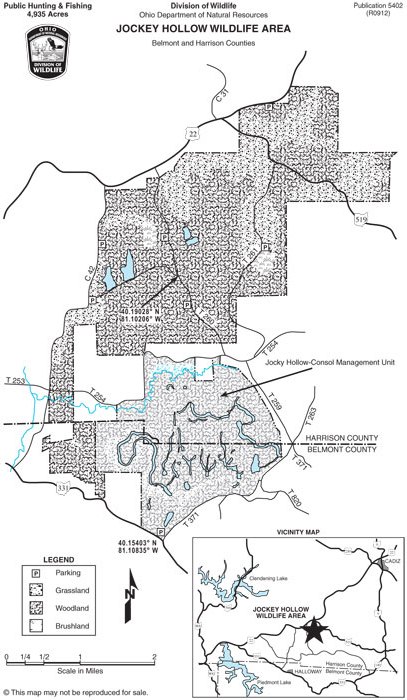Jockey Hollow Wildlife Area (Harrison Co.)
Jockey Hollow Wildlife Area (Harrison Co.)
Cravat Shop Road Moorefield, Ohio 43907
Official WebsiteAlso, see all the hotspots at:
Harrison County Birding Drive
About this Location
This 3,469-acre wildlife area lies 6 miles southwest of Cadiz in Harrison and Belmont Counties. Access is provided from OH-22 and OH-519. Several township roads provide direct access to the area. The area lies in an unglaciated region of eastern Ohio. The terrain is steeply rolling with some hilltops and valley floors. Second-growth hardwoods and conifers which cover most of the area are interspersed with brushy coverts and grassland. Consol Energy, Inc. owns 1,490 acres of the area and has an agreement with the Division of Wildlife to allow public access for wildlife-related activities.
Since the area was established in 2004, it has been managed as a public hunting area for forest wildlife. Hunting and trapping are the major recreational uses. Wildlife management activities include the planting of shrubs and trees, protection and improvement of existing woodland, selection of areas that will be allowed to return to woodlands through natural selection, and management of existing open fields.
The Consol-owned portion of the area was purchased by Consolidation Coal Company from the Crescent Valley Mining Corporation in 1955. The area was surface mined between 1958 and 1968 and called the Crescent Valley Mine. During this time around 200,000 tons of coal were produced from the Pittsburgh and Sewickley seams. The Consol-owned portion of the area was opened for public use in 2012.
Wildlife found in the area are common forest species including wild turkeys, ruffed grouse, fox and gray squirrels, and white-tailed deer. Raccoons, foxes, and coyotes are common furbearers in the area, and bobcats are occasionally seen. Woodland songbirds can be seen in abundance during the spring and fall migrations. Grassland songbird species can also be seen on some of the reclaimed mining portions of the property. Fishing is permitted in any pond found on this area. Channel catfish, largemouth bass, and bluegill are common species in these ponds.
Reforestation, post-mining, includes the planting of thousands of shrubs and trees. End dump reclamation has also been used in this area to help reestablish forested cover. Several high walls and spoil areas are found in the area as a result of previous mining operations.
State and township roads provide good access to the wildlife area. Several parking lots are situated throughout the area.
Features
Restrooms on site
Content from Official Website
